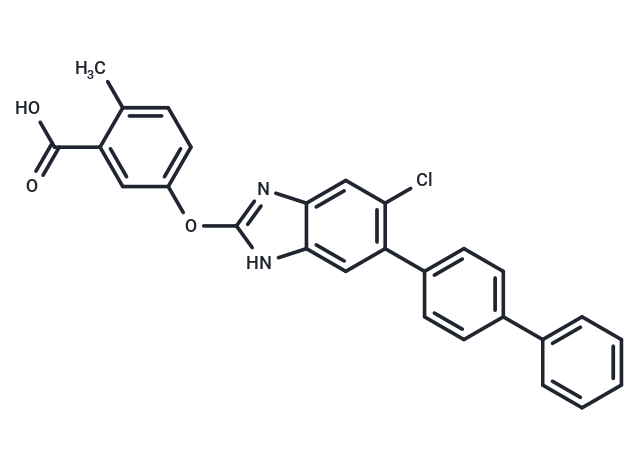Shopping Cart
- Remove All
 Your shopping cart is currently empty
Your shopping cart is currently empty

MK-3903, a potent and selective AMPK activator, has an EC50 of 8 nM.

| Pack Size | Price | Availability | Quantity |
|---|---|---|---|
| 1 mg | $30 | In Stock | |
| 5 mg | $73 | In Stock | |
| 10 mg | $123 | In Stock | |
| 25 mg | $198 | In Stock | |
| 50 mg | $372 | In Stock | |
| 100 mg | $619 | In Stock | |
| 200 mg | $877 | In Stock | |
| 1 mL x 10 mM (in DMSO) | $80 | In Stock |
| Description | MK-3903, a potent and selective AMPK activator, has an EC50 of 8 nM. |
| Targets&IC50 | AMPK:8 nM (EC50, cell free) |
| In vitro | MK-3903 activates 10 of the 12 phosphorylated AMPK (pAMPK) complexes with EC50 values in the range of 8 to 40 nM. MK-3903 partially activates pAMPK5 (36% max) and it does not activate pAMPK6. MK-3903 demonstrates low permeability in LLC-PK1 cells and is a substrate of human liver uptake transporters OATP1B1 and OATP1B3 (organic anion transporter proteins). MK-3903 binds moderately to the prostanoid DP2 (CRTH2) receptor (IC50: 1.8 μM) but not in the presence of 10% human serum (binding IC50>86 μM). |
| In vivo | The pharmacokinetics of MK-3903 in C57BL/6 mice, SD rats, and beagle dogs are characterized by moderate systemic plasma clearance (5.0 to13 mL/min/kg), a volume of distribution at steady state of 0.6 to 1.1 L/kg, and a terminal half-life of ~2h. In high-fructose fed db/+ mice, Acute oral administration of MK-3903 (3, 10, and 30 mg/kg) results in significant inhibition of hepatic fatty acid synthesis (FAS) for all three doses. |
| Kinase Assay | Briefly, the AMPK complex of interest is appropriately diluted in AMPK reaction buffer and incubated at room temperature for 30 min to yield pAMPK. Then, MK-3903 and pAMPK are pre-incubated by adding appropriately diluted MK-3903 in DMSO (1.2 μL total) to the reaction buffer containing pAMPK (15 μL per well), the plate is vortexed briefly and then incubated at room temperature for 30 min. The plate is sealed and incubated at room temperature for 60 min, at which time the reaction is stopped by the addition of quench buffer. EC50s and %activation parameters are calculated from %product vs. activator concentration plots. |
| Animal Research | DIO mice at 17 weeks of age are used in this study. Mice are conditioned to dosing with vehicle (5% Tween 80, 0.25% methylcellulose, 0.02% SDS) at 5 mL/kg BID for 5 days. At that time, mice are bled, glucose and insulin measured and the animals sorted into treatment groups based on glucose, insulin and body weight. Each group of animals receives the administration of MK-3903 in a vehicle at 3 mg/kg, 10 mg/kg, 30 mg/kg, or vehicle alone for 12-day BID. Another group of mice receiving MK-3903 with the vehicle at 30 mg/kg for 12-day QD is included as well. Food intake and body weight are measured daily. |
| Alias | MK 3903 |
| Molecular Weight | 454.9 |
| Formula | C27H19ClN2O3 |
| Cas No. | 1219737-12-8 |
| Smiles | Cc1ccc(Oc2nc3cc(Cl)c(cc3[nH]2)-c2ccc(cc2)-c2ccccc2)cc1C(O)=O |
| Relative Density. | 1.349 g/cm3 (Predicted) |
| Storage | Powder: -20°C for 3 years | In solvent: -80°C for 1 year | Shipping with blue ice. | |||||||||||||||||||||||||||||||||||
| Solubility Information | H2O: Insoluble DMSO: 50 mg/mL (109.91 mM), Sonication is recommended. Ethanol: Insoluble | |||||||||||||||||||||||||||||||||||
Solution Preparation Table | ||||||||||||||||||||||||||||||||||||
DMSO
| ||||||||||||||||||||||||||||||||||||

Copyright © 2015-2025 TargetMol Chemicals Inc. All Rights Reserved.